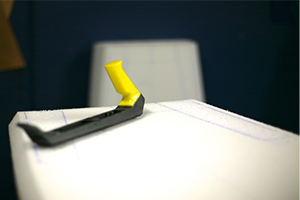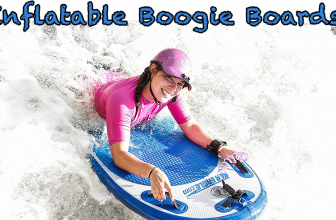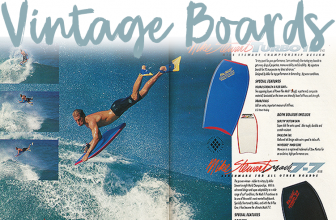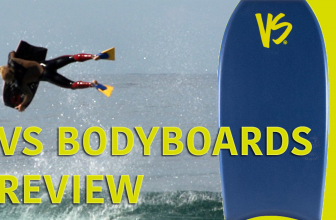
To create high-performance bodyboards, it is necessary to be using the proper, high-quality materials to make sure they can last and perform well.
More...
That does create the question though for many surfers or newbie bodyboarders: “What are bodyboards made of?”
Well, if you’re looking into crafting your own line of bodyboards, or just looking to get a new one for the summer, there are a few things you really must know about their designs.
Just a few decades ago, the polystyrene design was very popular, and you could find these cheap boards just about anywhere.
In modern times, bodyboard manufacturers treat them like surfboards, creating them from high-quality materials, giving them custom shapes, etc.
Let’s dive into the different parts of bodyboards so you can get a better idea of what to look for.
Top Deck
The deck is the part of the bodyboard that you will be lying on during your ride. There are two main types of decks that we often see in manufacturing.
8lb PE Deck
8lb (density per inch) polyethylene is the typical type of top deck that you will find on a bodyboard.
They are very soft to lie on, though also very flexible.
You’ll notice that this type of deck definitely starts to indent after a lot of time in the water, though this is pretty usual for bodyboards.
That being said, it is the top choice for many pro bodyboarders.

Crosslink
Crosslink is the cheaper kind of top deck that you’ll typically find in budget bodyboards. The structure is thinner than 8lb PE and is at about a 6lb density per inch. They tend to be much stiffer than the alternative, though also a lot more durable, so there is certainly a trade-off. If you have the money, the 8lb PE Deck is the more professional choice.
Rails
Rails, like on a surfboard, are the edges of your board that move from the nose of the board and back to the tail. Certain rails can help you to cut better into the faces of waves and some can help you to maneuver better in the water.
Rails come in two parts, the chine and the rail (we know, it’s a bit confusing). The chine is the top part of the rail and the rail is the bottom part. These are measured in ratios such as 50/50 or 60/40. A 60/40 measurement would have more chine than rail. That 60/40 measurement would also be much better for riding larger waves, as your rails have more exposure to the water to connect with.
50/ 50 rails mean that the chine and rail are equal. These are far better to maneuver with, though offer less face connection. While certain manufacturers will make special ratios like 70/30 or 45/55, the two above we mentioned are the most typical and your choice will really depend on how you want to ride.
Bottom
There are two main types of bottoms on bodyboards. These can also be referred to as “slicks.”
Surlyn
Surlyn is a modern type of bodyboard slick and is the best choice if you’re looking to get something professional and long-lasting.
Surlyn is the same type of polymer plastic that you’ll find on golf balls.
It has the same little indents in it, which make it extremely tough and resistant to creasing like cheaper slicks.

HDPE
HDPE, or high-density polyethylene, is a material that is actually quite similar in look and feel to Surlyn, though definitely not as tough. You’ll typically find HDPE bottoms in cheaper bodyboards and they will likely begin to crease after a lot of time in the water.
Core
Cores, though you can’t actually see them or touch them, pretty much define the performance level of your board.
A high-quality core can completely change how your board rides and getting the right one is important to progressing and hitting your goals as a bodyboarder. There are many types of cores, which is why this variable seems to confuse people more than anything else.

PolyPro / Polypropylene/ PP Bodyboard Core
Polypropylene is one of the most popular kinds of bodyboard cores out there and can also be a bit pricey when compared to other popular cores like polyethylene. That being said, it is worth every penny if you’re serious about riding. Polypropylene is very tough, lightweight, responsive in the waves, and performs better than most cores out there. You can either get extruded polypropylene or beaded polypropylene. Beaded floats much better in the water and is much better for those who like to ride a bit higher. Extruded polypropylene, on the other hand, is better for those who want to drive faster and possibly bust a few tricks, as they are light and more rigid.
Dow / PE Bodyboard Core
This type of core is what was found in the first types of bodyboards on the market back in the day. It’s very flexible and extremely responsive the moment you hit the water. If you’re going to be riding a lot in cold water, we highly recommend PE cores, as they can benefit from the extra stiffness cold water provides. If you’re not in cold water and want a board that you can easily flex and alter as you charge through waves, PE cores are great for that too.
Arcel Bodyboard Core
Arcel bodyboard cores are a mixture of 70% polystyrene and 30% polyethylene. Essentially they take some of the best qualities of the two components and blend them into a stiff beaded core. If you want a board that won’t flex as easily and will maintain it’s original shape for long periods of time, this is where Arcel cores excel.
NRG Bodyboard Core
NRG cores are the new wave of bodyboard tech. The expansion cell technology is pretty much the biggest demand in the world of pro bodyboarding, as it gathers the best qualities that pro riders need. NRG cores have the perfect amount of flex and pop nicely as well, making them great for competition rides where tricks are necessary.
EPS Bodyboard Core
EPS cores can be found on the lower-end of bodyboards. Though EPS cores seem to gather a lot of flack from pro bodyboarders, technology has actually taken them far from where they used to be. They are easily the most durable out of all the cores out there and are crazy lightweight too. These stiff cores are perfect for newbies who are just getting into diving on broken waves.
Quad Bodyboard Core
Quad bodyboard cores are pretty unique in that we don’t see them around, as they are manufactured for special occasions. They’re made with multiple layers and fused with polypropylene. These boards end up being much faster than PP boards, drive better through waves, and are incredibly tough.
X Flex Mesh
X Flex Mesh is another odd kind of core, as it is essentially more of a stiffener than anything. The X Flesh looks like chicken wire and is laid across the core or bottom side of a deck to give the board a bit more spring. Having X Flex Mesh can help keep your board from flexing too much.
Stringers
Stringers are rods that can be found in cores. They help to make your board stiffer, as well as help them to maintain their shape. A good set of stringers can bring longevity to your bodyboard. They run along the length of the board and will typically stop about a half a foot away from the nose. There are many different types of stringers out there that can affect your board in different ways. The three most popular are:
CFT stringers are composite fiber tube stringers that add strength and spring.
EXT stringers are epoxy fiber tubes that add stiffness and overall durability in shape.
Trident Stringers are tri-set CFT stringers that add strength without giving the board too much rigidness.
Frequently Asked Questions
How do you choose the right size bodyboard for yourself?
There are size charts out there, though sometimes it is just better to find out in person. There are two “methods” that many bodyboarders use to see if the board is the right size for them. The most popular way is using your bellybutton. The nose of your bodyboard should reach your bellybutton if you put the tail end on the ground.
What kind of shape should I look for?
While there are a variety of shapes, there are essentially two main kinds of shapes that you should look for depending on how you ride:
Prone boards are wide near the front and are great for those who are looking to remain lying down while riding.
Dropknee boards have a wide point further down near the tail and a tapered nose section. These are excellent for drop knee riders, as you can situate your weight a bit further back while keeping balanced.
Final Thoughts
Hopefully, you now have all the information you’ll need to get started on your bodyboard quest, whatever that may be.
There is so much information out there that you may have never thought of, but if you love the sport, you’ll love exploring how different setups can change the way you ride!




